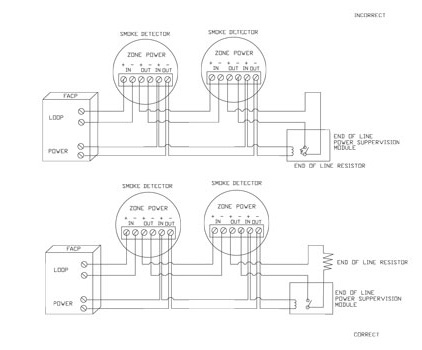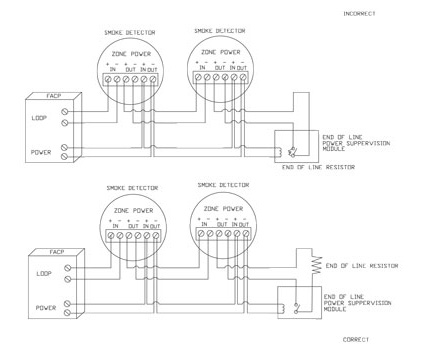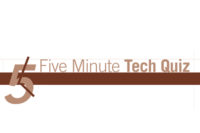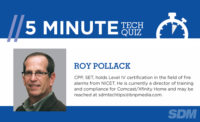1. Carbon Monoxide (CO) detectors or alarms in new residential applications are to be installed
a. outside each separate dwelling unit sleeping area in the immediate vicinity of the bedrooms.
b. one for every 900 square feet of living space and one on each level.
c. on every level of a dwelling unit, including basements.
d. a and b
e. a and c
2. Where a conflict with the standards exists, the installer should verify his installation with the
a. owner.
b. authority having jurisdiction (AHJ).
c. manufacturer.
d. office for guidance.
3. The terms smoke alarm and smoke detector are interchangeable.
a. True
b. False
4. Smoke detectors, when properly mounted on the ceiling or wall, should be at
a. least four inches off the corner and 12 inches from the ceiling.
b. least 12 inches off the corner and four inches from the ceiling.
c. least four inches off the corner and within 12 inches of the ceiling.
d. least 15 feet from all walls and within 12 inches of the ceiling.
5. The UL® standard for CO detectors is
a. NFPA 720.
b. UL 720.
c. UL 2075.
d. NFPA 72.
6. When an end-of-line power supervision module activates on a smoke detector it
a. opens the circuit.
b. closes the circuit.
c. creates a short on the circuit.
d. lights the LED on the last smoke detector it is connected to.
7. CO detectors work by
a. sensing CO over a short period of time.
b. sensing CO over a long period of time.
c. sensing CO over either a short period of time or a long exposure.
d. reacting immediately to any concentration of CO present.
8. Which of these CO sensing technologies have a limited life:
a. biomimetic
b. MOS
c. electrochemical
d. All have limited life.
e. There is no designated life span. Proper testing and operation means the detector may continue in place.
9. The CO sensing technology that has the highest current draw is
a. CMOS.
b. MOS.
c. electrochemical.
d. biomimetic.
10. Both two-wire and four-wire smoke detectors are required to have an end-of-line power supervision module installed at the last detector.
a. True
b. False
11. Smoke detectors of the two-wire and four-wire type can be mixed on a single system
a. if the panel manufacturer has provisions for both types of devices.
b. as long as the devices are from a single manufacturer.
c. when the AHJ approves of such an installation.
d. can not be mixed due to voltage fluctuations and increased current draw.
12. Smoke detectors in an addressable system may never be T-tapped.
a. True
b. False
11. To be UL® compliant the installer should make certain that the CO detector chosen for the application
a. has been thoroughly tested prior to installation.
b. incorporates a built-in supervisory circuit that sends a signal to the control panel when the device has reached its end of life.
c. is monitored by a UL®-listed central station.
d. is an approved device as listed in NFPA 720.
12. The installer should advise the central station to verify the CO detector activation with the customer prior to dispatch to avoid false alarms and comply with CP-01 standards.
a. True
b. False
14. Carbon monoxide detectors of which type may be susceptible to false alarms due to household cleaning solutions that contain ammonia such as glass cleaners:
a. biomimetic
b. MOS
c. electrochemical
d. electromechanical
What’s Wrong With This?
An alarm technician installed a residential fire alarm system with multiple smoke detectors. The panel required end of line supervision for the four wire detectors. In addition, he installed a power supervision module but the alarm kept activating. Can you help him out?

|
Answer to: What’s Wrong With This?
The alarm technician installed the end of line resistor in the wrong spot. When power was present the relay was closed, causing an alarm condition. Properly installed and with power, the resistor supervises the loop from the fire panel. Upon a loss of power the relay opens and causes a trouble condition on the loop circuit.

|
5-Minute Tech Quiz Answers
1. e
2. b — The Authority Having Jurisdiction (AHJ) has the final decision power on what is acceptable in his/her jurisdiction.
3. b
4. c
5. c — The UL document is 2075, Standard for Gas and Vapor Detectors and Sensors.
6. a
7. c
8. d
9. b
10. b
11. a — Two- and four-wire devices can be mixed on the same panel, but not the same circuit. The four-wire devices would still need EOL power supervision modules.
12. b — Because they are addressable, the panel interrogates each device, so T-tapping is permitted.



